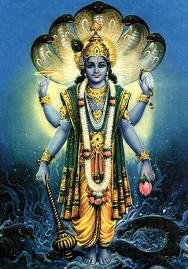 |
Essence Of
Bhavishya Purana
|
| 3 ‘Samskaras’ (Sacred Rites) | |
Vedas and Shastras prescribed forty kinds of ‘Samskaras’, relevant to Brahmanas among the ‘Chaturvarnas’ or Four Castes ranging from ‘Garbha Dhaan’/ ‘Rutusanti’ (Impregnation); ‘Pumsavana’, a Sacred Rite after third month of Conception; ‘Seemantonnayan’, literally meaning the parting of hair of the pregnant mother or the Rite performed in the sixth or eighth month of pregnancy; ‘Jaata Karma or cutting of the navel-tube; ‘Naamkarana’ or giving a name to the child; ‘Annaprasasna’ giving the first morsel of food; ‘Chooda Karma’ or cutting the lock of hair of the baby; ‘Upanayana’ ( Sacred Rite of wearing Holy Thread and ‘Upadesha’or Instruction of Gayatri Mantra); Four-folded Veda Vrata; Vivaha (Wedding); ‘Pancha Maha Yagna’ or the Sacrifices addressed to Devas, Pitras, Human Beings, Pancha Bhutas and Brahma to satisfy them; ‘Sapta Paaka Yagna Samstha’ or Seven-folded Sacrifices of Cooked Materials viz.’Ashtakaadvaya’, ‘Paarvana’, ‘Shraavani’, ‘Aagrahaayani’, ‘Chaitri’/’Shulagava’and ‘Aashvayuji’; ‘Sapta havijna Samstha’ or Seven-folded ‘Havis’ or oblations in Agni /Fire viz. ‘Agnyadhaan’, ‘Agni-hotra’, ‘Darsha-Pournamasa,’ ‘Chaaturmaasya’, ‘Niruddha Pashu Bandha’, ‘Soutramani’; and ‘Sapta Soma Samstha’ viz. ‘Agnishtoma’, ‘Athaygnishtoma’, ‘Ukthya’, ‘Shodashi’, ‘Vaajapeya’, ‘Atiraatra’and ‘Aaptoryami; these are the Samskaras relevant to Brahmanas. The Brahmanas are expected to practise Eight ‘Atma Gunas’ or Self-oriented Features or Characteristics viz. Anasuya Dayaa Kshaantiranaayasam cha Mangalam, Akaarpanyam tathaa shouchamaspuhaa cha Kuruduha! (The seven salient features of Brahmanas are non-jealousy, Mercifulness, Forgiveness, unconcern, propitiousness, equanimity, inward and outward cleanliness and detachment).The Sacred Rites like Garbhadhaan, Pumsavan, Seemantotrayan, Jatakarma, Anna -praashana, Chuda karma and Yagnopaveet are meant of removing ‘beeja-sambandhi’ or Seed-related Doshas or Blemishes, whereas Vedaadhyana (Study of Vedas), Vratas or Pujas, Homams (Fire Rituals), Tri Vidya Vratas, Devarshi-Pitru ‘Tarpanas’ (Water oblations), ‘Putrotpaadana’, Pancha Maha Yagna and such other Jyotishtoma Yagnas are targetted to ‘Brahma Praapti’ or attaining Salvation. Jaatakarma, a ritual for boys is performed along with Veda Mantras on the tenth day, or twelfth day, or eighteenth or on the completion of birth; the infant is taken out from the house either on the twelfth day or the fourth month and this act is called ‘Nishkraman’. During the sixth month, ‘Annaprashana’or first touch of food is performed; either during the first or third year his ‘Mundan’ or first hair-cut is done. In the fifth or eighth year Yagnopaveet Samskar is performed to Brahmanas; the sixth or eleventh year after birth for Kshatriyas, and during the eighth or twelfth year to Vaishyas. But this Sanskar is futile beyond sixteenth year for Brahmanas, twenty two years for Kshatriyas and twenty fourth years for Vaishyas; such persons are known as ‘Vraatya’ and are not qualified for wearing the ‘Yagnopaveeta’, unless a Ritual called ‘Vatsyashtom Yagna’ is performed for ‘Prayaschittha’ or purification. Brahmanas are expected to perform ‘Achamana’ before taking up any Sacred Ritual, after cleaning hands and feet seated on a clean ‘Asana’ or Seat looking East or North, with the right hand on the right thigh, sipping spoonfuls of water reciting the names of Keshava, Narayana, Govinda and so on. The act of Achamana is not to be done while standing, conversing, looking sideways without concentration, or in a hurry and least of all while being angry or with a disturbed mind. It is stated that in a Brahmana’s right palm are five ‘Tirthas’viz. Deva Tirtha (on top of the four fingers excepting the thumb), Pitru Tirtha at the bottom of the pointing finger, Brahma Tirtha at the bottom of the middle wrist, Prajapatya Tirtha underneath the little finger and Soumya Tirtha at the center of the palm. Hence, all Achananas etc. related to Deva Karmas including ‘Devarchana’/ Pujas of Devas or giving dakshina or ‘daana’ (charity) to Brahmanas are to be performed from the finger tops excepting the thumb; Tarpanas, Pinda daanas, or all acts related to Pitras are done from Pitru Tirthas; Achamana is executed from Brahma Tirtha or at the bottom of right palm above the wrist; Prajaparthya Tirtha area is utilised to perform all the propitious tasks involving Weddings, Upanayanas etc. and Soma Tirtha is utilised for certain other tasks like ‘Kamandalu grahana’ or accepting Holy Water Vessels or ‘Dadhi Prashana’ ceremonies. As Achamanas are carried out, the first sip of water signifies Rig Veda, the second sip for Yajur Veda, the third one for Sama Veda; later on when the right thumb touches the face, Atharva Veda is satisfied, when the lips are touched Itihaasas and Puranas are contented, when water is sprinkled on the head Bhagavan Rudra is gladdened, Rishiganas are happy as the tuft is touched, when both the eyes are touched Surya Deva is satisfied, touch of the nose satisfies Vayu Deva, ears satisfy the Ten ‘Dishas’ or Directions, and shoulders make Yama Dharma Raja, Kubera, Varuna, Indra and Agni Deva satisfied. Also, when Brahmanas perform Achamana, they should touch eyes with thumb along with Tarjani (fore finger), nose with thumb along with Anamika finger, face with thumb and Madhyama finger, ears with thumb and Kanishtha (little) finger, shoulders with all fingers, thumb with navel, and all the fingers with head; Angushtha is of Agni Swarupa, Tarjani Vayu, Madhyama Prajapati, Anamika is of Surya Rupa, and Kanishthika of Indra. Another precaution is that Brahmanas must perform Achamana involving Brahma Tirtha, Prajapatya Tirtha, and Deva Tirtha, but not Pitru Tirtha. | |
 Prev:Creation and Concept of Time Prev:Creation and Concept of Time | |
 Next:Creation and Concept of Time
Next:Creation and Concept of Time